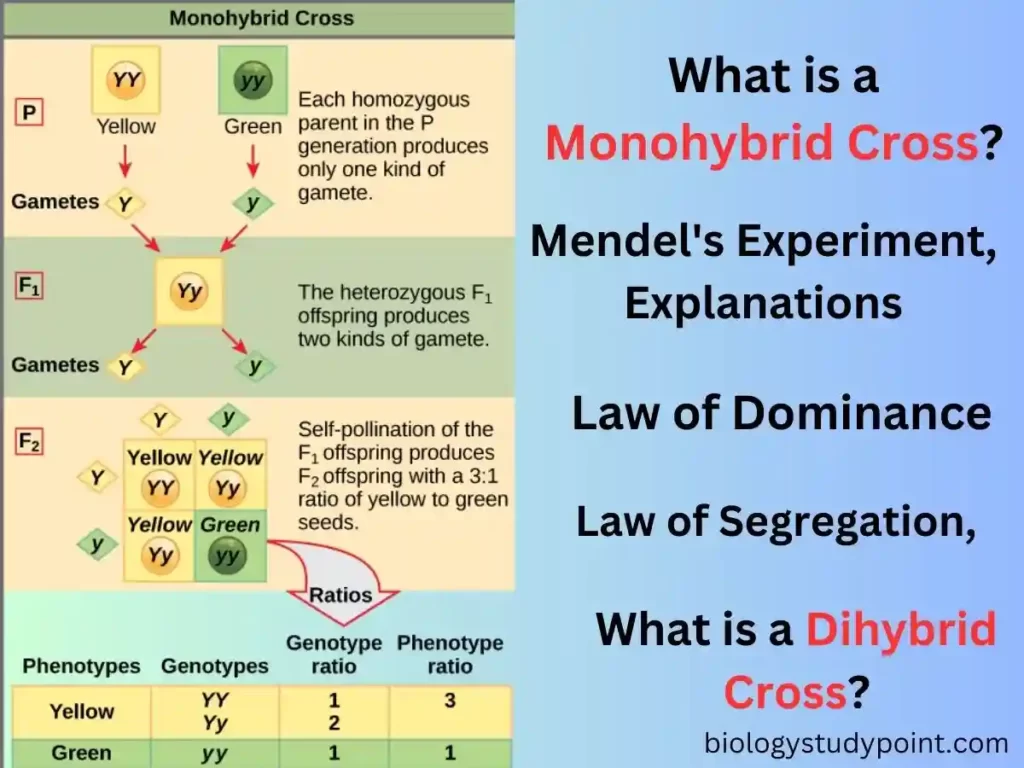Hello, guys, In today’s this article we will study about monohybrid cross?. Like — What is a monohybrid cross? What is a dihybrid cross? Law of dominance, We will know the answers to many such questions today, so let’s start.
What is a monohybrid cross?
Monohybrid cross involves inheritance of one pair of contrasting characters, such as tall and dwarf characters or red and white flower color, etc. The results of monohybrid cross in F2 generation are in 3 : 1 ratio.
Which of the following can be concluded from Gregor Mendel’s experiments with pea plants?
Mendel’s Experiments –
Mendel cross-pollinated two varieties of Pisum sativum pure or homozygous for tall and dwarf (P1 generation) characters. The seeds obtained as a result of cross-pollinated grew into tall progeny, and he named it first filial generation (F1). Now he allowed the F1 plants to self pollinate.
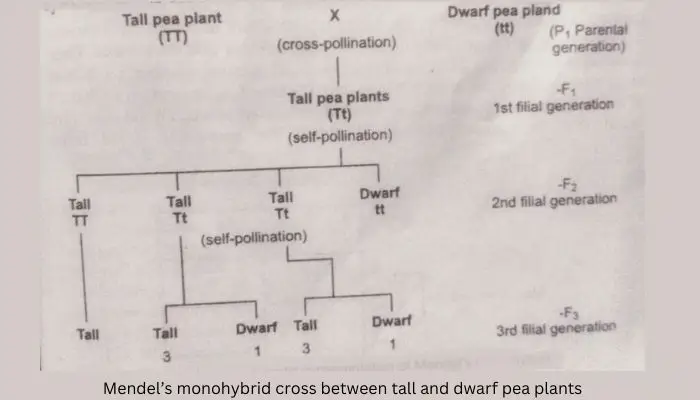
The offspring of this generation (i.e., second filial generation or F2) were both tall and dwarf in the ratio of 3:1. O self-pollination, the dwarf plants of F2 were found to breed true to dwarfness in succeeding generations. Of the tall Plants of F2 generation, only 1/3rd breeds true to tallness, while the rest 2/3rd produced tall and dwarf in the ratio of 3 : 1 (F2 generation).
Mendel’s Explanation –
Mendel presumed that.
- The tallness and dwarfness are dependent on a pair of contrasting factors or determiners, the genes. A plant is tall since it possesses determiners for tallness (T) and a plant is dwarf because it has determiners for dwarfness.
- These determiners are present in duplicate in each cell of the living beings.
- These determiners T and t are separate entities but when the two are present together in an offspring only one, i.e., tallness develops, masking the dwarfness.
- In F2 generation when hybrids are self-pollinated, the two entities segregate out independently so that 1/3rd of total progeny of F2 breeds true to dwarfness and 1/3rd for tallness. Based on that, Mendel proposed the following laws. These are :
- Law of segregation
- Law of dominance and recessiveness
Law of segregation definition biology –
The law of segregation states that the two contrasting factors or allelomorph present together in a heterozygote, do not become contaminated but segregate out in the gametes so that a gamete possesses only one out of two factors.
For example, tallness (T) and dwarfness (t) are two independent but contrasting factors present in the heterozygote which develops tall character but possesses genes or determiners for both tallness and dwarfness.
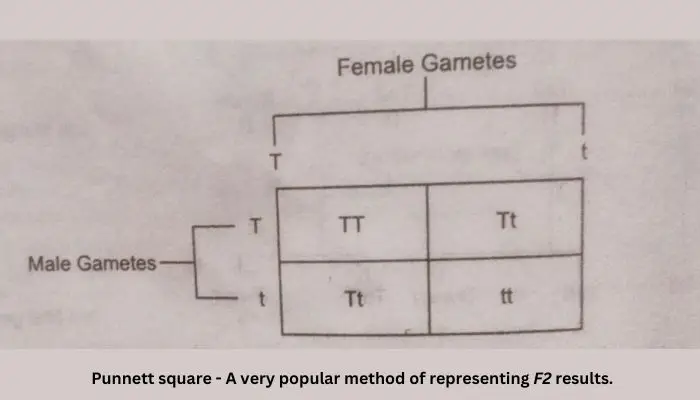
These heterozygotes produce gametes of two types and in equal numbers, i.e., 50% of them possess T and the other 50% are with t. These fuse at random so that 1⁄4 of the total progeny possess tt and develop into dwarf plants.
Of the talls 1/3rd breed true to tallness having TT while the remaining 2/3rd being heterozygous produce talls and dwarfs in the ratio of 3 : 1 in F3 generation. Similarly, 2/3rd of the talls from the F2 generation again produce tall and dwarf.
This shows that although tallness (T) and dwarfness (t) are contrasting characters, yet they retain their individuality from generation to generation and segregate out at the time of gamete formation.
What is the law of dominance?
According to this law, two genes of an allelomorphic pair are related as dominant and recessive. It means that in a heterozygote out of the two alleles coming from two different parents, both are not able to express themselves.
Only one expresses its effect, suppressing the other. The one which owes its expression at the cost of others is known as dominant, and the other one which is suppressed is the recessive.
For example, tallness (T) is dominant over dwarfness (t). Homozygous tall and dwarf breed true to their character and produce only tail or only dwarf plants. But heterozygous tall (Tt) of F1 generation, though possess both the factors for all and dwarf characters, are tall because tallness is dominant and dwarfness recessive.
What is a dihybrid cross?
Law of Independent Assortment –
Dihybrid cross involves study of inheritance of two pairs of characters, such as inheritance of yellow and green color of seeds and round and wrinkle character of seeds.
Mendel’s Experiment –
Mendel studied segregation and transmission of two pairs of contrasting characters at a time. He crossed pea plants having round and yellow seeds with plants having wrinkled and green seeds. The cross produced only round and yellow seeds in F1 generation.
When the plants raised from F1 seeds were self-pollinated, produced four types of seeds in F2 generation. Two of these combinations were similar to the parental combination, while the other two were new combinations. These are –
| Round yellow | 9 |
| Wrinkled green | 1 |
| Round green | 3 |
| Wrinkled yellow | 3 |
Thus, the offsprings of F2 generation were produced in the ration of 9 : 3 : 3 : 1.
The results can be represented as follows :
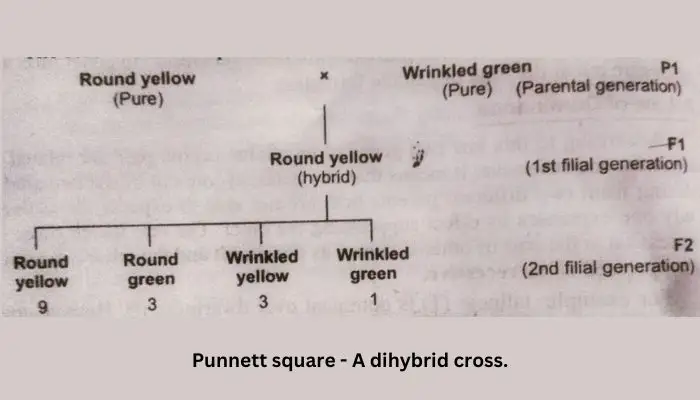
Mendel’s Explanation –
Mendel represented the round character of seeds by R and wrinkled by r. Similarly, he designated the yellow character by Y and green by y. Therefore, it was a cross between RRYY and rryy. The of F2 can be obtained by the checkerboard method.
Mendel explained the results by assuming that the round and yellow characters are dominant over wrinkled and green so that all the F1 offsprings are round yellow. In F2 generation since all the four characters were assorted out independent of the others, he said that a pair of alternate or contrasting characters behave independently of the other pair, i.e., seed color is independent of seed coat.
Therefore, at the time of gamete formation, genes for round or wrinkled characters of seed coat assorted out independently of the yellow or green color of the seed. Thus, four types of gametes with two old and two new combinations i.e., RY, ry, Ry, rY are formed.
These on random fusion produce four types of combinations in the ratio of 9 : 3 : 3 : 1 in F2 generation. This is called dihybrid ratio.
The results of dihybrid cross can be represented through checkerboard of Punnett. The results of F2 generation of a dihybrid cross show that each character is an independent unit. At the time of gamete formation, it is free character is an independent unit and at the time of gamete formation, it is free to segregate and combine with any other character of the parents. Based on these observations, Mendel proposed his third law of inheritance as the law of independent assortment.
According to Mendel’s third law, the law of independent assortment in a dihybrid or polyhybrid cross, the distribution of factors for characters in the gametes and their transmission to the next generation is independent of each other.
In a dihybrid or polyhybrid cross, during gamete formation, the segregation of membranes of a pair of alleles is independent of the segregation of other pairs of alleles.
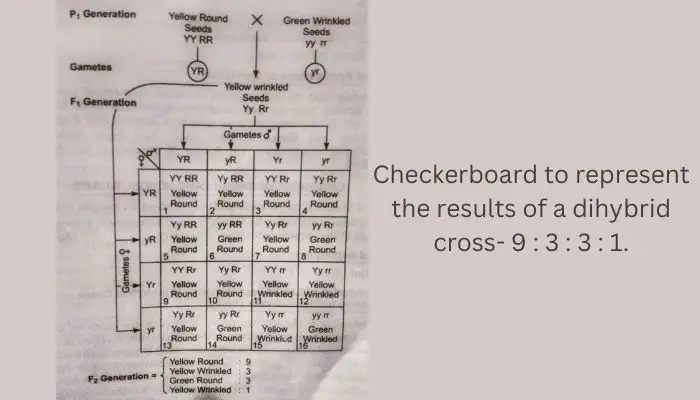
You will get the answers to all the questions given below in the article.
Which is a monohybrid cross?
What is dihybrid cross in biology?
What are Monohybrid and dihybrid cross?
What is monohybrid cross F2 generation?
What is Monohybrid inheritance and the law of segregation?
What is the Mendel experiment?
Conclusion –
So friends, in today’s article we have studied What is a monohybrid cross? Friends, if you like this article, then please comment, share and tell your suggestions and our mistakes.
Thank you so much
